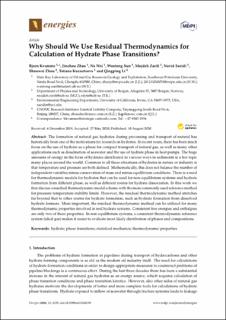| dc.contributor.author | Kvamme, Bjørn | |
| dc.contributor.author | Zhao, Jinzhou | |
| dc.contributor.author | Wei, Na | |
| dc.contributor.author | Sun, Wantong | |
| dc.contributor.author | Zarifi, Mojdeh | |
| dc.contributor.author | Saeidi, Navid | |
| dc.contributor.author | Zhou, Shouwei | |
| dc.contributor.author | Kuznetsova, Tatiana | |
| dc.contributor.author | Li, Qingping | |
| dc.date.accessioned | 2021-05-07T13:15:11Z | |
| dc.date.available | 2021-05-07T13:15:11Z | |
| dc.date.created | 2020-09-24T14:24:11Z | |
| dc.date.issued | 2020 | |
| dc.identifier.issn | 1996-1073 | |
| dc.identifier.uri | https://hdl.handle.net/11250/2754213 | |
| dc.description.abstract | The formation of natural gas hydrates during processing and transport of natural has historically been one of the motivations for research on hydrates. In recent years, there has been much focus on the use of hydrate as a phase for compact transport of natural gas, as well as many other applications such as desalination of seawater and the use of hydrate phase in heat pumps. The huge amounts of energy in the form of hydrates distributed in various ways in sediments is a hot topic many places around the world. Common to all these situations of hydrates in nature or industry is that temperature and pressure are both defined. Mathematically, this does not balance the number of independent variables minus conservation of mass and minus equilibrium conditions. There is a need for thermodynamic models for hydrates that can be used for non-equilibrium systems and hydrate formation from different phase, as well as different routes for hydrate dissociation. In this work we first discuss a residual thermodynamic model scheme with the more commonly used reference method for pressure temperature stability limits. However, the residual thermodynamic method stretches far beyond that to other routes for hydrate formation, such as hydrate formation from dissolved hydrate formers. More important, the residual thermodynamic method can be utilized for many thermodynamic properties involved in real hydrate systems. Consistent free energies and enthalpies are only two of these properties. In non-equilibrium systems, a consistent thermodynamic reference system (ideal gas) makes it easier to evaluate most likely distribution of phases and compositions. | en_US |
| dc.language.iso | eng | en_US |
| dc.publisher | MDPI | en_US |
| dc.rights | Navngivelse 4.0 Internasjonal | * |
| dc.rights.uri | http://creativecommons.org/licenses/by/4.0/deed.no | * |
| dc.title | Why should we use residual thermodynamics for calculation of hydrate phase transitions? | en_US |
| dc.type | Journal article | en_US |
| dc.type | Peer reviewed | en_US |
| dc.description.version | publishedVersion | en_US |
| dc.rights.holder | Copyright the authors. | en_US |
| dc.source.articlenumber | 4135 | en_US |
| cristin.ispublished | true | |
| cristin.fulltext | original | |
| cristin.qualitycode | 1 | |
| dc.identifier.doi | 10.3390/en13164135 | |
| dc.identifier.cristin | 1833102 | |
| dc.source.journal | Energies | en_US |
| dc.identifier.citation | Energies. 2020, 13 (16), 4135. | en_US |
| dc.source.volume | 13 | en_US |
| dc.source.issue | 16 | en_US |

